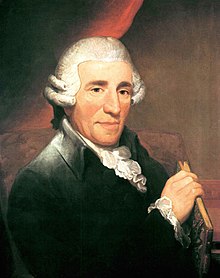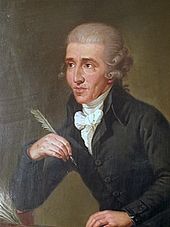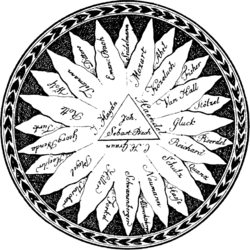Joseph Haydn
![]()
Haydn is a redirect to this article. For other meanings, see Haydn (disambiguation).
Franz Joseph Haydn (born 31 March or 1 April 1732 in Rohrau, Archduchy of Austria; † 31 May 1809 in Vienna) was an Austrian composer of the Viennese Classical period.
Joseph Haydn, brother of the composer Michael Haydn and the tenor Johann Evangelist Haydn, spent the greater part of his professional career as a court musician at the country estate of the wealthy Hungarian Esterházy family, whose orchestra and opera he conducted. He described his seclusion from other composers and musical trends by saying, "I was secluded from the world, no one near me could mislead and torment me about myself, and so I had to become original."
Haydn's setting of the poem Gott! erhalte Franz, den Kaiser, Unsern guten Kaiser Franz! , the Kaiserlied, became one of the Austrian imperial anthems and, with a different text, later the German national anthem.

Joseph Haydn (oil painting by Thomas Hardy, 1791)

Italian signature of Joseph Haydn: di me giuseppe Haydn ("from me Joseph Haydn")
Services
Haydn is traditionally considered the "father" of the classical symphony and string quartet, and was an innovator in writing piano sonatas and piano trios. Although other composers of the early classical period, such as Carl Philipp Emanuel Bach for the piano sonata and Johann Stamitz or Johann Christian Bach for the symphony, played an important role, Haydn's influence is considered to be predominant.
|
Detail from an engraving published towards the end of the 18th century by an English organist who also published Bach's Well-Tempered Clavier. The author counted Haydn among the best composers. |
In addition, Haydn also contributed to the development of the sonata form from a simple formal scheme derived from the "sonata bipartita" to a dramatized, subtle and flexible form of musical expression. Characteristic of the comprehensive nature of the significance of this form are its variants, such as the sonata rondo form, and for flexibility the variation form with two themes and the integration of fugue and contrapuntal elements into the string quartet.
August Heinrich Hoffmann von Fallersleben based his Song of the Germans, composed in 1841 on the then British island of Helgoland, on the sage of Haydn's imperial anthem "Gott erhalte Franz, den Kaiser, unsern guten Kaiser Franz" (see above), which became the national anthem of the German Reich during the Weimar Republic and the National Socialist dictatorship, as well as of the Federal Republic of Germany, with changing use of the stanzas.
Structure of the music
A central characteristic of Haydn's music is the development of larger structures out of very small and simple musical motives. The music is often formally quite concentrated, and the important musical events of a movement can unfold rapidly.
Many of Haydn's works are structured according to sonata form, albeit with some peculiarities compared to Mozart and Beethoven. In the exposition, Haydn often does not use a contrasting "second theme" when reaching the dominant; instead, he repeats the opening theme or a similar theme. In the recapitulation, he often changes the order of the themes compared to the exposition.
Haydn's compositional practice influenced both Mozart and Beethoven. What was special about the compositional style of the three Viennese classics were three highly developed procedures: obligato accompagnement, openwork style and motivic-thematic work.
Perhaps more than any other composer, Haydn is known for the jokes he put into his music. The most famous example is the sudden loud chord in Symphony No. 94 "with the timpani beat." Other examples: the feigned ending in the Quartets Op. 33 No. 2 and Op. 50 No. 3, or the rhythmic illusion he placed in the Trio Op. 50 No. 1.
Development of Haydn's style
If one traces Haydn's work over the five decades (roughly 1749 to 1802) in which it was created, one finds a gradual but steady increase in complexity and musical refinement that evolved as Haydn learned from his own experience and that of his colleagues. One can identify several important milestones in the evolution of Haydn's musical style.
In the late 1760s and early 1770s Haydn wrote works that can be classified as "Sturm und Drang", characterized by passionate musical language and daring harmonies. Anton Reicha wrote in 1814 that Haydn had undergone a thorough revision of his compositional style:
"Haydn studied his art constantly. [...] After many works, he began again completely with the technique of composition at the age of 40, in order to consolidate himself in this skill, and to better understand its secrets."
Most of the symphonies with numbers between 35 and about 55 are of this type. During this period he engaged in contrapuntal studies and experimented with writing fugues that are in the Viennese tradition of Italian origin (J. J. Fux) and have less to do with the fugue works of J. S. Bach, conspicuously in the final movements of the six string quartets (Sonnenquartette) op. 20 (1772).
In 1781 Haydn published six op. 33 string quartets, with an announcement to potential purchasers that they were written "in an entirely new, special way." Charles Rosen has discussed that this declaration on Haydn's part was not merely marketing but quite serious; he points to a number of important advances in Haydn's style that appear in these quartets. These include the fluidity of phrasing, in which each motive emerges from the preceding one without interruption; the custom of allowing accompanying material to develop into melodic material; and the type of 'classical counterpoint' in which each instrumental part retains its own integrity, corresponding to what Beethoven called 'obligato accompagnement'. These features continue in the many quartets Haydn wrote after op. 33.
From 1781/1782 Haydn had a lively exchange of ideas with W. A. Mozart. Both recognized each other as equal masters, became friends and learned from each other. Musicologists therefore speak of a pre-Mozartian and a post-Mozartian period in Haydn's life. An older contemporary whose work Haydn acknowledged as an important influence for his work was Carl Philipp Emanuel Bach, the second son of Johann Sebastian Bach.
Haydn was also friends with the Viennese lutenist Carl Kohaut, who also played Haydn's compositions for the lute (solo compositions, lute duos and other works).
In the 1790s, Haydn, inspired by his travels in England, developed what Rosen calls his "popular style," a way of composing that produced, with unprecedented success, music that had great popular appeal yet possessed an erudite and rigorous musical structure. An important element of the popular style was the frequent use of Austrian or Croatian folkloric (or invented pseudo-folkloric) material. Haydn strove to use such material in appropriate places, such as at the ends of sonata expositions or as opening themes of final movements. At such points, the folkloric material serves as an element of stability that helps anchor the larger structure. Joseph Haydn's popular style can be heard in almost all of his later works, for example in the twelve London symphonies, the late quartets and piano trios, and the two late oratorios.

Joseph Haydn (painting by Ludwig Guttenbrunn, c. 1770)
Instruments
The fortepiano "Anton Walter in Vienna", which Haydn played, is now on display in the Haydn Haus in Eisenstadt. In 1788 Haydn bought a fortepiano from Wenzel Schantz in Vienna. During his first stay in London, the English piano maker John Broadwood provided him with a concert grand.
Search within the encyclopedia
